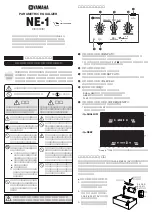
indicated by a repeating sequence of flashes on the red LED indicator (see the
Diagnostic LED Codes
section below for more information).
The card may be removed at any time. In that case, both the green and red LED indicators should turn
off, then the Basic mode is started.
The optional contact inputs are ‘debounced’ by sampling them using a periodic interrupt. The sample
rate is 50 Hertz (20 milliseconds). Valid input closures are detected by reading a 0 - 0 - 1 (open, open,
closed) sample sequence. Valid input opens are detected by reading a 1 - 1 - 0 (closed, closed, open) sample
sequence.
The status of the unit while loading and scanning is also displayed via messages sent out the serial port.
Using a PC with “Tera Term”, “HyperTerminal” or other terminal emulator software connected to the
Compact FLASH IV Digital Audio System
serial port the card loading and scanning messages may be
viewed. The serial data format defaults to 2400 baud, 8 data bits, 1 stop bit and no flow control. Samples of
these messages are shown in the Appendix.
Background Audio Tracks
Sounds labeled with the
“B”
token in their filename after the hex number are played in numerical
sequence as background sounds when no other audio tracks are being played, continuously repeating the
sequence. A background audio track will cease playing when any other sound file is triggered to play by
contact closure or serial command. Once that sound file is finished playing, the background audio file that
was playing will resume playing from the point where it was interrupted and continue to play until again
interrupted.
















































